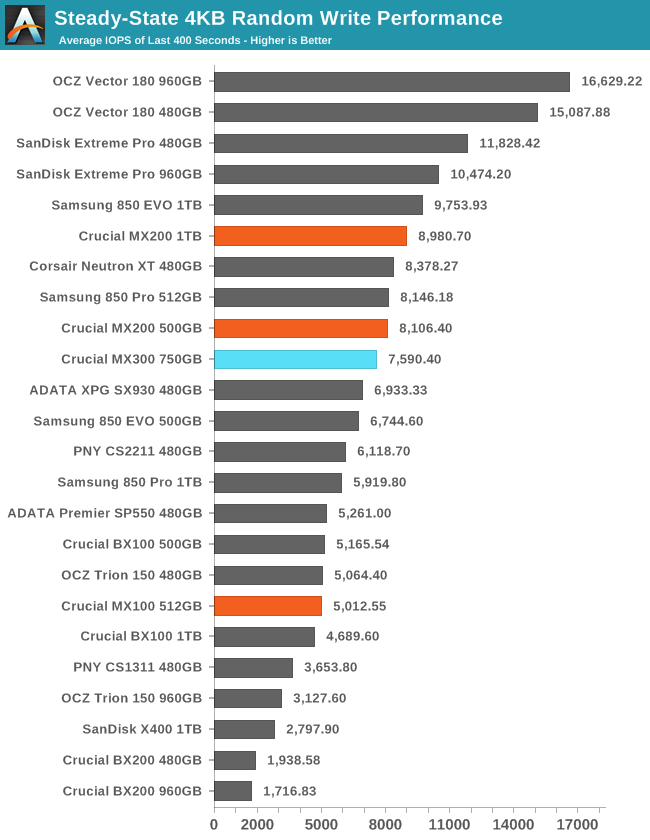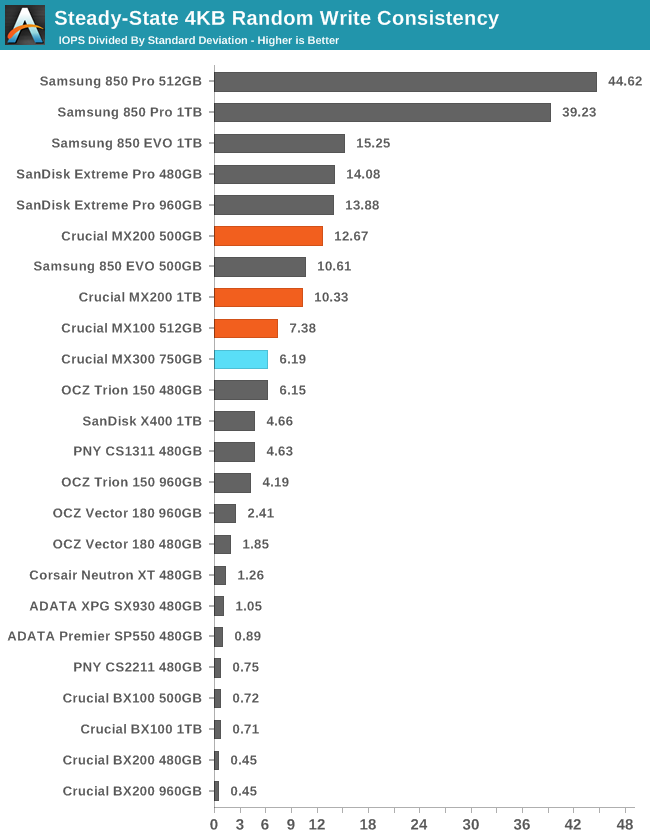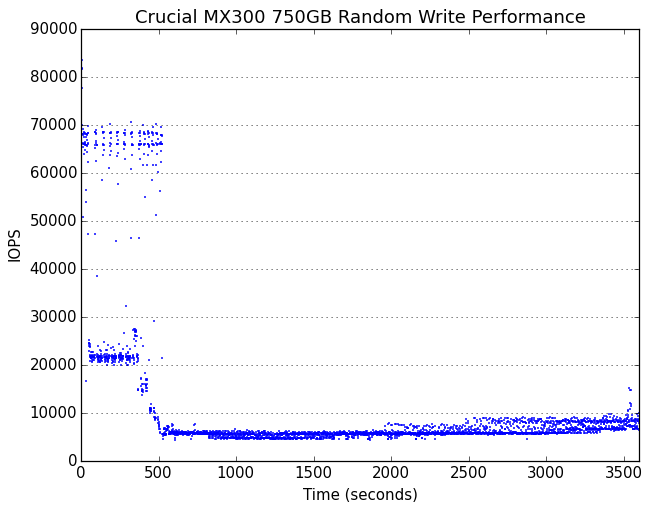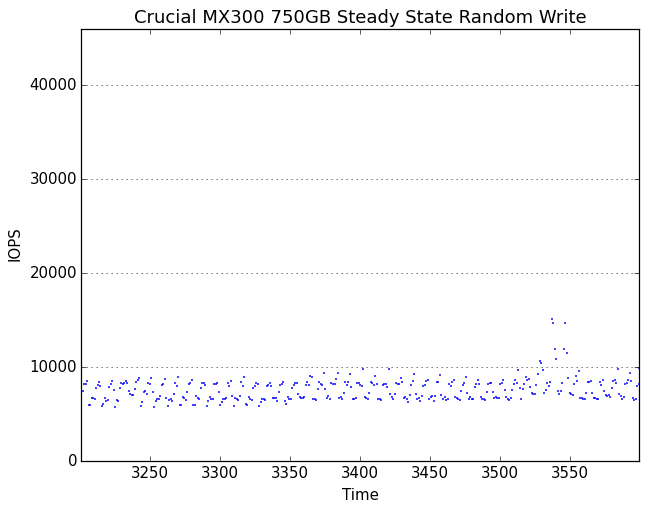The Crucial MX300 750GB SSD Review: Micron's 3D NAND Arrives
by Billy Tallis on June 14, 2016 9:00 AM ESTPerformance Consistency
Our performance consistency test explores the extent to which a drive can reliably sustain performance during a long-duration random write test. Specifications for consumer drives typically list peak performance numbers only attainable in ideal conditions. The performance in a worst-case scenario can be drastically different as over the course of a long test drives can run out of spare area, have to start performing garbage collection, and sometimes even reach power or thermal limits.
In addition to an overall decline in performance, a long test can show patterns in how performance varies on shorter timescales. Some drives will exhibit very little variance in performance from second to second, while others will show massive drops in performance during each garbage collection cycle but otherwise maintain good performance, and others show constantly wide variance. If a drive periodically slows to hard drive levels of performance, it may feel slow to use even if its overall average performance is very high.
To maximally stress the drive's controller and force it to perform garbage collection and wear leveling, this test conducts 4kB random writes with a queue depth of 32. The drive is filled before the start of the test, and the test duration is one hour. Any spare area will be exhausted early in the test and by the end of the hour even the largest drives with the most overprovisioning will have reached a steady state. We use the last 400 seconds of the test to score the drive both on steady-state average writes per second and on its performance divided by the standard deviation.

The MX300's steady state random write performance is below the MX200 but stays slightly ahead of the 850 EVO and well ahead of any planar TLC drive.

The MX300 earns a consistency score that is below the MX200 but about average, and certainly high enough for ordinary consumer workloads.
 |
|||||||||
| Default | |||||||||
| 25% Over-Provisioning | |||||||||
The MX300 lasts for over eight minutes before the SLC cache and spare area are completely exhausted, but during that phase it alternates between operating at about 22k IOPS and 65-70k IOPS. During the steady state phase there is gradual improvement in performance along with an increase in variability.
 |
|||||||||
| Default | |||||||||
| 25% Over-Provisioning | |||||||||
The steady state random write performance of the MX300 varies periodically between about 6k IOPS to 10k IOPS, with no outliers of slow performance. With extra overprovisioning performance is substantially higher and consistency is a bit better.










85 Comments
View All Comments
Impulses - Wednesday, June 15, 2016 - link
Most users are still served fine by lower cost SATA drives and they'll probably remain common for years to come... And nobody is using SATA Express, wouldn't be surprised if it disappears from mobos, stillborn interface.M.2/PCI-E vs SATA is almost like 7,200+ RPM vs 5,400 RPM at this point.
Adam-James - Thursday, June 16, 2016 - link
"And nobody is using SATA Express..."That's part of the problem. Why is this a state of affairs that we're OK with? To me, the fact that no manufacturer has yet released, or has future plans to release, a SATA Express drive is infuriating, and even more so when they continue to put out AHCI SATA drives. That every flash manufacturer is so satisfied with the status quo and uninterested in improving the technology they sell is outrageous. And they're following the same pattern with U.2 - I've read about at least one executive who had the gall to claim his company wasn't adopting it for their SSD line because consumers "aren't interested." The industry might be satisfied with mediocrity, but we shouldn't be.
Impulses - Friday, June 17, 2016 - link
I don't think it's about mediocrity on the manufacturer's party... It's just a mediocre interface. M.2/U.2 are far better suited for next gen drives, and if you don't need that kinda performance (and most people don't) then SATA is fine. SATA Express represents an awkward middle ground that would potentially bottleneck next gen PCI-E/M.2 drives, so it seems the industry just said "why bother?".KAlmquist - Wednesday, June 15, 2016 - link
1. Samsung's accomplishment with the 850 EVO looks even better today. I was expecting that the Intel/Micron product would be as good as the Samsung 3D NAND when it finally came to market. But it appears that the 1.5 year old Samsung 3D TLC NAND is faster than the 3D TLC NAND that Intel/Micron has just introduced.2. Fifteen months ago we were hearing claims that Intel/Micron 3D NAND would have "disruptive pricing." Currently, the 750GB MX300 sells for its list price of $200. Last October, hypothetical 750GB BX-100 SSD would have cost $232. (This price is computed by averaging the price of the 500GB and 1TB models.) That's a 14% price decrease over eight months, which is significant, but hardly "disruptive." Perhaps we will see some aggressive pricing in the future, once production ramps up, but for now "disruptive pricing" isn't happening.
We can hope that Toshiba/SanDisk 3D NAND (which should appear this year) will prove more exciting. There's also SK Hynix, which as far as I know is currently using its 3D NAND only in enterprise products.
Impulses - Wednesday, June 15, 2016 - link
Indeed.ST33LDI9ITAL - Friday, June 17, 2016 - link
Name other SSD's at this price point that also have power protection and full encryption/edrive support....ST33LDI9ITAL - Sunday, June 19, 2016 - link
Exactly... it's not all about performance... features matter too. This drive has good performance, good feature set, and good prices. It is an all around great mainstream drive.dananski - Friday, June 17, 2016 - link
Makes me so glad to have gotten a BX100 when they came out. Why can't they pull off something like that again? The budget drive that competed with Samsung on general performance and beat everything on power consumption.ZapNZs - Sunday, June 19, 2016 - link
Are the endurance specs correct? It seems unlikely the TLC in the MX300 will be anywhere near the MX200, even regardless of capacity differences.Billy Tallis - Tuesday, June 21, 2016 - link
Yes, the endurance specs are correct. I can't say for sure that the MX300 specs are equally conservative as the MX200 specs, but the whole point of 3D NAND is to enable a return to larger memory cells that are more like the ones from the early days of the SSD revolution, where even tiny drives had high endurance ratings because they had P/E cycle ratings that were five or six digits long instead of three or four. 3D NAND makes it possible to have big memory cells and still have a lot of them on one chip.